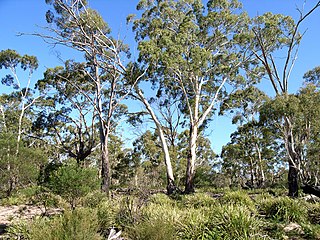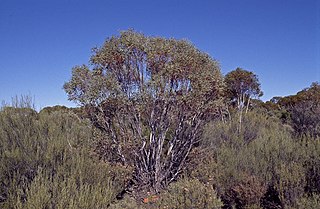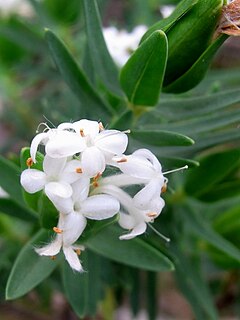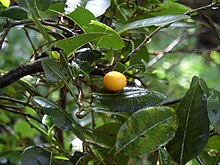
Eucalyptus viminalis, commonly known as the manna gum, white gum or ribbon gum, is a species of small to very tall tree that is endemic to south-eastern Australia. It has smooth bark, sometimes with rough bark near the base, lance-shaped to curved adult leaves, flower buds in groups of three or seven, white flowers and cup-shaped or hemispherical fruit.

Angophora costata, commonly known as Sydney red gum or smooth-barked apple, is a species of medium-sized to tall tree that is endemic to eastern Australia. It has smooth bark, lance-shaped leaves arranged in opposite pairs, flower buds usually in groups of three, white or creamy white flowers and ribbed, oval or bell-shaped fruit.

Eucalyptus leucoxylon, commonly known as yellow gum, blue gum or white ironbark, is a species of small to medium-sized tree that is endemic to south-eastern continental Australia. It has smooth yellowish bark with some rough bark near the base, lance-shaped or curved adult leaves, flower buds in groups of three and cylindrical, barrel-shaped or shortened spherical fruit. A widely cultivated species, it has white, red or pink flowers.

Olea paniculata, commonly known as the native olive, is a plant of the genus Olea and a relative of the olive. It grows natively in Pakistan and southwestern China (Yunnan) through tropical Asia to Australia and the Pacific islands of New Caledonia, Vanuatu and Lord Howe Island.

Eucalyptus flocktoniae, commonly known as merrit, is a species of tree or mallee that is endemic to Western Australia. It has smooth, silvery grey bark, lance-shaped to curved adult leaves, prominently beaked flower buds in groups of seven or nine and barrel-shaped or urn-shaped fruit.

Drypetes deplanchei is a tree of eastern and northern Australia. It also occurs in New Caledonia and Lord Howe Island. The genus is derived from the Greek, dryppa meaning "olive fruit". The species named after Dr. Emile Deplanche, who collected this plant at New Caledonia. Common names include yellow tulip, grey boxwood, white myrtle, grey bark and yellow tulipwood.

Sarcomelicope simplicifolia, commonly known as bauerella, hard aspen or yellow-wood, is a species of flowering plant in the family Rutaceae and is endemic to eastern Australia including Lord Howe and Norfolk Islands. It is a shrub or small tree with elliptic to egg-shaped leaves arranged in opposite pairs, male or female flowers arranged in small groups in leaf axils and fruit an oval to spherical drupe.

Eucalyptus loxophleba, commonly known as York gum, daarwet, goatta, twotta or yandee is a species of tree or mallee that is endemic to Western Australia. It has rough bark on the trunk, smooth olive to brownish bark above, lance-shaped adult leaves, flowers buds in groups of between seven and eleven, white flowers and conical fruit.

Eucalyptus leptopoda, commonly known as the Tammin mallee, is a species of mallee or rarely a tree, that is endemic to Western Australia. It has smooth mottled grey or brownish bark, sometimes with rough bark near the base, linear to curved adult leaves, flower buds usually in groups of seven and eleven, creamy white flowers and hemispherical to flattened spherical fruit.
Trophis scandens subsp. megacarpa is a flowering plant in the mulberry family. The subspecific epithet comes from the Greek mega ("big") and carpos ("fruit"), with reference to the larger fruits in this subspecies.
Symplocos candelabrum is a flowering plant in the sapphireberry family. The specific epithet may refer to the candelabrum-like display of stamens in the flower.

Pimelea congesta is a flowering plant in the Thymelaeaceae family. The specific epithet refers to the congested inflorescence.

Celtis conferta subsp. amblyphylla, commonly known as cotton wood or cotton-wood, is a flowering plant in the hemp and hackberry family.
Melicytus novae-zelandiae subsp. centurionis is a flowering plant in the family Violaceae. It is a subspecies of Melicytus novae-zelandiae, known in New Zealand as coastal mahoe. The subspecific epithet honours the military Captain James Doran McComish (1881–1948), who made several visits in the 1930s to collect plants on Lord Howe Island.

Olearia elliptica subsp. praetermissa is a flowering plant in the daisy family. The subspecific epithet means "overlooked", referring to the fact that this distinctive endemic subspecies was long overlooked.
Leptospermum polygalifolium subsp. howense, commonly known as tea tree or tea-tree, is a flowering plant in the myrtle family, Myrtaceae. The subspecific epithet refers to the island to which the subspecies is endemic.
Passiflora herbertiana subsp. insulae-howei is a flowering plant in the passion flower family. The subspecific epithet refers to the island to which the subspecies is endemic.
Piper excelsum subsp. psittacorum, commonly known as pepper tree or kava, is a flowering plant in the family Piperaceae. The subspecific epithet means “of the parrots”, inferring a liking by parrots for the fruits.
Pouteria myrsinoides subsp. reticulata, commonly known as axe-handle wood, is a flowering plant in the sapodilla family, Sapotaceae. The subspecific epithet refers to the reticulate venation on the leaves.

Eucalyptus socialis, commonly known as the red mallee, or grey mallee, is a species of mallee that is endemic to inland Australia.













